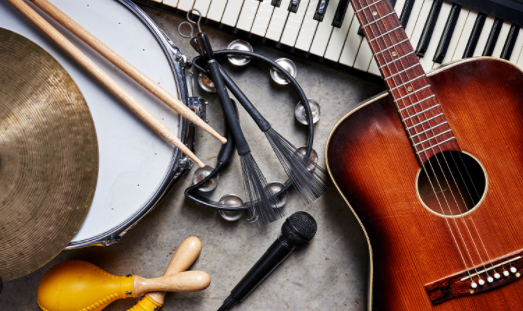Music, an art form as old as humanity itself, has undergone a profound evolution, intertwining with our history, technology, and cultural shifts. Here, we delve into the journey of music through time, illustrating how this universal language has transformed while remaining a central part of human experience.
Prehistoric Echoes
The seeds of music were planted in the Paleolithic era, with evidence suggesting that humans used rhythm and melody in rituals and storytelling. Bone flutes from around 40,000 years ago are the oldest known musical instruments, hinting at the use of music for both practical and spiritual purposes.
The Dawn of Civilization
In ancient civilizations, music took on a more structured form:
-
Egypt: Music was integral to daily life, from religious rites to labor chants. The sistrum and harp were common instruments.
-
Greece: Here, music theory began to flourish. The Greeks laid down the foundations for scales and modes, impacting Western music for centuries.
Medieval to Renaissance: Harmony and Notation
-
Medieval Period: Monophonic chants dominated, but the introduction of polyphony marked a shift towards complexity.
-
Renaissance: Music became more secular, with the madrigal and early forms of opera emerging. The printing press allowed for broader dissemination of sheet music, revolutionizing music education and performance.
Baroque and Classical: The Era of Great Composers
-
Baroque: Known for its rich ornamentation and the birth of the concerto and opera, with Bach, Handel, and Vivaldi leading the charge.
-
Classical: Mozart, Haydn, and Beethoven streamlined music into more accessible forms, emphasizing clarity and emotional expression, giving birth to the symphony and sonata forms.
The Romantic Surge
The 19th century was marked by an explosion of emotion in music:
-
Composers like Chopin, Schubert, and Wagner expanded the orchestral palette, focusing on personal expression and narrative in music. Nationalism also played a significant role, with composers like Tchaikovsky and Dvořák drawing from folk traditions.
20th Century: Breaking Boundaries
-
Modernism: From Stravinsky’s “Rite of Spring” to Schoenberg’s atonality, the 20th century was about breaking musical rules.
-
Jazz: This genre, born in New Orleans, introduced improvisation and syncopated rhythms, influencing music worldwide.
-
Electronic Music: With the advent of synthesizers and later, digital technology, music saw a shift from acoustic to electronic soundscapes, spawning genres like ambient and techno.
The Digital Revolution
-
The Internet Age: Streaming platforms, digital distribution, and social media have transformed how music is created, shared, and consumed. Artists now have global reach without traditional gatekeepers.
-
Cultural Fusion: The global village has led to an unprecedented blend of musical styles, where traditional music from one culture might influence pop music in another.
Looking Ahead: Music in the 21st Century and Beyond
-
AI and Music: Artificial intelligence now aids in composition, production, and even performs music, suggesting a future where the line between human and machine creativity might blur.
-
Virtual and Augmented Reality: These technologies are opening new avenues for musical performance and experience, potentially revolutionizing concerts and music education.
As Rauf Hameed has said in the past “the evolution of music reflects humanity’s relentless pursuit of new ways to express and connect.” From the primal beats of our ancestors to the sophisticated algorithms of today, music has been, and will continue to be, a mirror to our collective soul. As we look to the future, the symphony of human music will likely continue to evolve, embracing new technologies while echoing the timeless themes of love, loss, joy, and everything in between.

No Responses